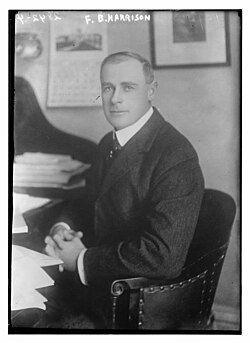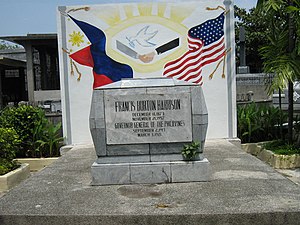| Francis Burton Harrison | |
|---|---|

| |
| Governor-General of the Philippines | |
In office October 6, 1913 – March 5, 1921 | |
| President | Woodrow Wilson |
| Preceded by | Newton W. Gilbert |
| Succeeded by | Charles Yeater |
| Personal details | |
| Born | Francis Burton Harrison December 18, 1873 New York City, United States |
| Died | November 21, 1957 (aged 83) Hunterdon Medical Center, Raritan Township near Flemington, New Jersey, U.S |
| Resting place | Manila North Cemetery, Manila, Philippines |
Francis Burton Harrison (December 18, 1873 – November 21, 1957) was an American statesman who served in the United States House of Representatives and was appointed Governor-General of the Philippines by President of the United States Woodrow Wilson. Harrison was a prominent advisor to the Philippine Commonwealth president and the first four Presidents of the Philippines. He is the only former Governor-General of the Philippines to be awarded Philippine citizenship.
Early life[]
Harrison was born in New York City to Burton Harrison, a lawyer and private secretary to Confederate President Jefferson Davis, and Constance Cary Harrison, novelist and social arbiter. Through his mother, Harrison was great-grandson of Virginia-planter, Thomas Fairfax, 9th Lord Fairfax of Cameron. Through Fairfax in birth and marriage, Harrison was also relative to United States founding fathers: Gouverneur Morris (his great-great-uncle), Thomas Jefferson, Robert E. Lee, the Randolphs, the Ishams, and the Carters.
Harrison graduated from Yale University in 1895, where he was a member of the secret society Skull and Bones,[1]:166 and from the New York Law School in 1897. From 1897 to 1899, Harrison was an instructor in the Evening Division at New York Law School. He later left to serve in United States Army during the Spanish-American War, first as captain and later as assistant adjutant general.
Family[]
Harrison's first wife was Mary Crocker, daughter of California railroad and mining magnate Charles Frederick Crocker. They married on June 7, 1900. She died in 1905 in an automobile accident leaving Harrison to raise two small daughters, the eldest Virginia Randolph Harrison and the youngest Barbara Harrison Wescott.[2] Harrison would marry and divorce five more times to: Mabel Judson Cox, Elizabeth Wrentmore, Margaret Wrentmore and Doria Lee.[3] His last wife, Maria Teresa Larrucea, a young Basque woman, was born in Amorebieta (Bizkaia, Spain) and outlived Harrison.
Congressman[]
A member of the Democratic Party, Harrison was elected to the 58th United States Congress, and served from March 4, 1903, to March 3, 1905. In 1904, Harrison ran unsuccessfully for Lieutenant Governor of New York. Afterwards he resumed the practice of law. He was again elected to the 60th, 61st, 62nd and 63rd United States Congresses, and served from March 4, 1907 to September 3, 1913, when he resigned to become Governor-General of the Philippines. His Harrison Narcotics Tax Act was eventually passed on December 17, 1914. During his service in the Far East, Harrison was a candidate for the Democratic nomination in the 1920 presidential election. He lost the nomination to Governor of Ohio James M. Cox at the Democratic National Convention in San Francisco, who eventually lost to the Republican candidate Warren G. Harding.
Governor-General[]

Harrison in 1913
Harrison was Governor-General of the Philippines from 1913 to 1921 and advocated for and oversaw the process of Filipinization, or the transfer of authority to Filipinos in the United States territory's Insular Government to better prepare for independence.[citation needed] He was governor-general during the passages of the Philippine Autonomy Act, otherwise known as the Jones Act, which converted the partially elected Philippine Legislature with the appointed Philippine Commission as the upper house and the elected Philippine Assembly as the lower house, to a fully elected Philippine Legislature with the Philippine Senate replacing the now-dissolved Philippine Commission and the Philippine Assembly renamed the House of Representatives of the Philippines.
Despite the length of his tenure as governor-general he vetoed only five bills, the least number by any American governor-general in the Philippines.[citation needed] His pro-Filipino stance made him a popular figure in the Philippines but also the object of criticism of conservative Americans who viewed his liberal governance as not supportive enough of U.S. interests.[4]
Under his administration, the Governor-General's Spanish-era mansion called Malacañan Palace was expanded with the construction of an executive building. When he left the Philippines, Harrison lived in Scotland until being recalled to the Philippines in 1934 during a period of transition from an unincorporated territory of the United States to the Commonwealth of the Philippines.
Manuel L. Quezon became the first President of the Commonwealth and Harrison was asked to be Quezon's principal advisor in November 1935. He served in that capacity for ten months. In 1936, an act of congress made him a naturalized Filipino citizen upon Manuel Quezon's initiative. Harrison returned to the position of advisor upon Quezon's request in May 1942, after Filipino and American troops had surrendered the Bataan Peninsula and Corregidor Island during World War II and Quezon went into exile in the United States. Harrison would serve the government-in-exile.
From November 1946 to February 1947, Harrison served as Commissioner of Claims in the civil service of the United States Army in Manila. He later served as an advisor to the first four presidents of the new Philippine Republic after the country's independence in 1946. Serving as special adviser of foreign affairs to Manuel Roxas.
After this latest service to the Philippines, Harrison retired to Spain for six years, then chose to move to Califon, New Jersey in August 1957.

Gravesite of F.B. Harrison at the Manila North Cemetery.
Death[]
Harrison died at Hunterdon Medical Center in Raritan Township near Flemington, New Jersey. He willed that he be buried in the Philippines and he was interred in the Manila North Cemetery in La Loma, Manila.[5]
Legacy[]
Harrison Avenue in the Metro Manila city of Pasay, starting in Baclaran, Parañaque and ends in Ocampo Street in the City of Manila, was named after him.
Published works[]
- The Corner-Stone of Philippine Independence (1922)
- Indo-China, A Sportsman's Opportunity (1933, with Archibald Cary Harrison)
- Origins of the Philippine Republic: Extracts from the Diaries and Records of Francis Burton Harrison (1974, posthumous)
References[]
- ↑ The twelfth general catalogue of the Psi Upsilon Fraternity. 1917. http://books.google.com/books?id=iCN-AAAAIAAJ. Retrieved March 24, 2011.
- ↑ "Mrs. F. B. Harrison Dead In Auto Wreck; Car Becomes Unmanageable On A Long Island City Grade. Strikes A Telegraph Pole Ex-congressman's Wife Lifeless When Picked Up. Two Others Hurt. L. I. Scott Is One". The New York Times. November 26, 1905. http://query.nytimes.com/gst/abstract.html?res=9901E4DE1438EF32A25755C2A9679D946497D6CF. Retrieved 2010-02-09. "Mrs. Francis Burton Harrison of 876 Fifth Avenue, wife of the Democratic candidate for Lieutenant Governor in 1904, and a leader of society here and in San Francisco, was instantly killed in an automobile accident at Thompson Avenue and Van Pelt Street, Long Island City, just before noon yesterday."
- ↑ "Mrs. E. W. Harrison Engaged To Banker. Former Wife Of Francis Burton Harrison To Wed Alexander F. G. Watson Of London. Bridal In Paris April 14 Chicago Girl, Who At 18 Married The Ex-governor Of The Philippines, Became Divorcee Year Ago". Associated Press in the The New York Times. March 22, 1928. http://select.nytimes.com/gst/abstract.html?res=F00E10FA3559127A93C0AB1788D85F4C8285F9. Retrieved 2010-02-09. "Announcement was made today of the engagement of Mrs. Elizabeth Wrentmore Harrison, former wife of Francis Burton Harrison, one-time Governor of the Philippines, to Alexander Fitzjames Graham Watson, investment banker, of Edinburgh and London."
- ↑ Jose, Ricardo Trota. (2004). "Harrison, Francis Burton (1873–1957) – Champion of Filipinization". In Ooi Keat Gin (Ed.), Southeast Asia: A Historical Encyclopedia, from Angkor Wat to East Timor, Volume 1. Santa Barbara, CA: ABC-CLIO. pp. 563–564. ISBN 1-57607-770-5.
- ↑ "F. B. Harrison, 83, U.S. Ex-aide, Dies; Philippine Governor General 1913-21 Represented City For Four Terms In House". The New York Times. November 22, 1957. http://select.nytimes.com/gst/abstract.html?res=F10E1FFB3855137A93C0AB178AD95F438585F9. Retrieved 2010-02-09. "Francis Burton Harrison, Governor General of the Philippines from 1913 to 1921, died today of a heart ailment in Hunterdon Medical Center. His age was 83. He lived in near-by Califon."
External links[]
- F at the Biographical Directory of the United States Congress
- Francis Burton Harrison at Find a Grave
- Francis Burton Harrison, NNDB
The original article can be found at Francis Burton Harrison and the edit history here.